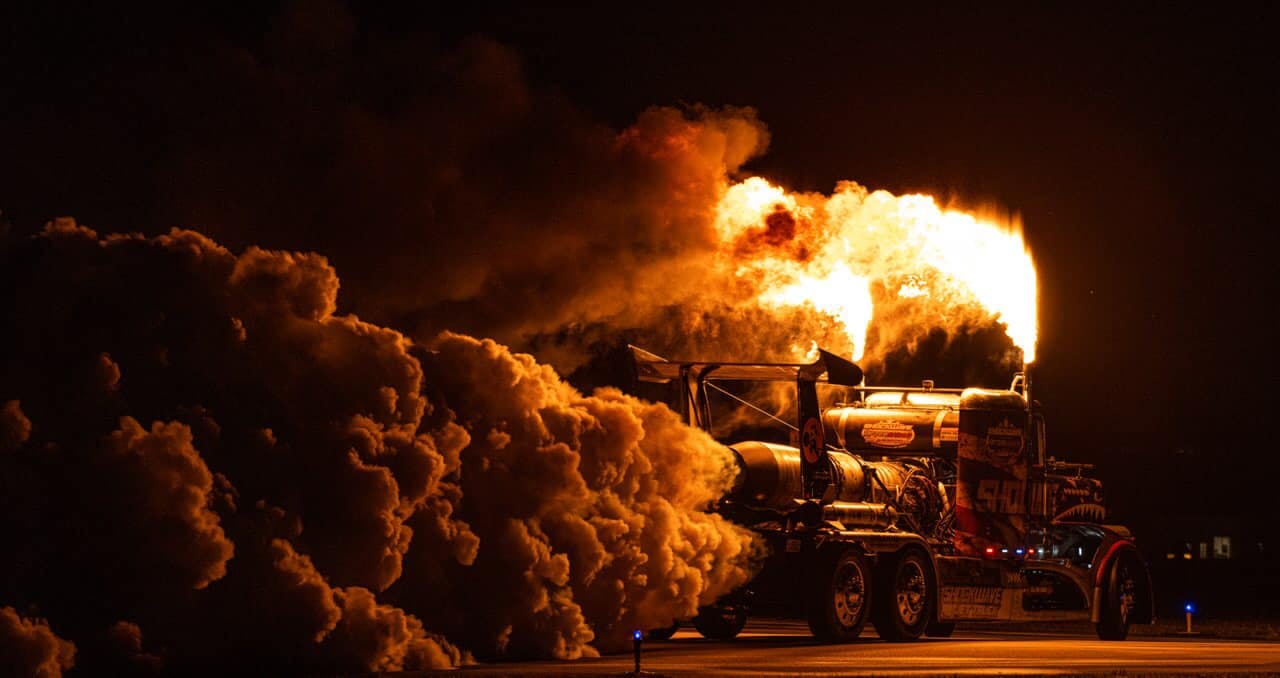Media | Articles
Shockwave, the legendary jet truck, crashes and claims life of driver Chris Darnell
There was a big party for Chris Darnell on his birthday a month ago; he got a pair of snarling new boots with a red and white shark’s mouth full of teeth stitched to the side. Appropriate for the man who drove perhaps the baddest vehicle in the world—the triple jet-engine Shockwave truck, capable of doing 384 mph. It wasn’t the fastest truck—its little brother, the Super Shockwave, has reportedly topped 400 mph—but seeing the massive, 7000-pound Peterbilt charging down a drag strip or airport runway is more impressive.
That’s what Darnell was doing Saturday July 2, just after noon at the Executive Airport in Battle Creek, Michigan, at the Battle Creek Field of Flight Air Show, when a disaster struck that claimed his life. He was “racing” a pair of propeller-driven stunt planes which were flying upside-down just above the runway. About midpoint, there was a flash gasoline explosion that was a planned part of the show. Some videos made it look like Darnell drove through the explosion, but he was hundreds of feet away.
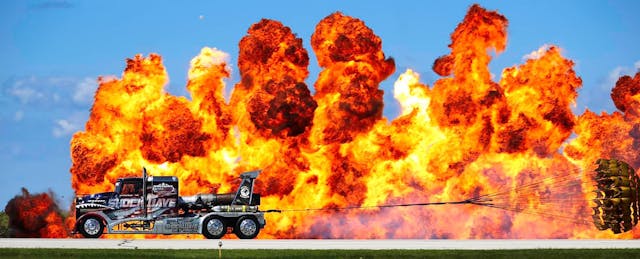
He was in real trouble. There were flames atop the engines where they weren’t supposed to be. The jet-powered truck, likely traveling about 275 mph and accelerating, snapped to the right and began a series of barrel-rolls down the runway, ending up in a cloud of smoke and dust.
Out of respect to Darnell, and to clean up the debris, the show was canceled.
Battle Creek’s Runway 5L-23R is over 10,000 feet long and 150 feet wide. Of the 24 shows Darnell was schedule to perform at this year at various venues, Field of Flight, the eighth, should have been one of the easiest. With plenty of room on a runway—especially compared to the quarter-mile drag strips where Darnell made exhibition runs—and a well-rehearsed show set, Darnell should have been packed up and headed to this weekend’s show, America’s Freedom Fest in Goshen, Indiana, by Monday.
Marketplace
Buy and sell classics with confidence
Instead, father Neal Darnell (Shockwave co-driver and co-owner) is left to plan a funeral for his youngest son. Neal said a “mechanical” issue caused the Shockwave to crash.
“We are so sad,” Neal posted on Facebook. “He was so well loved by everyone who knew him. Chris so loved the Air Show business. He was ‘Living the Dream,’ as he’d say.”

***
Jet cars have been around since the late 1950s and ‘60s, when they began to get popular with drag race shows as an exhibition act, thanks in large part to pioneer Les Shockley, a professional drag racer. For Shockley, it made sense, really: Military surplus jet engines could be had for as little as $700. Maintenance is much less than on a regular Top Fuel dragster—you just strap the jet engine to a chassis and hold on.
Plenty of racers did just that in the ‘60s and ‘70s. There was rarely a race class for them, so they, as now, typically close the show with violent, gut-wrenching “burner pops,” when unburned fuel—typically diesel—is injected into the engine and then ignited. Jet cars make smoke, fire, noise that can be heard for miles. And when they are the size of Shockwave, they grease down the track and require that everything mobile be secured down. Drag strips may not like jet vehicles, but they bring out the crowds.
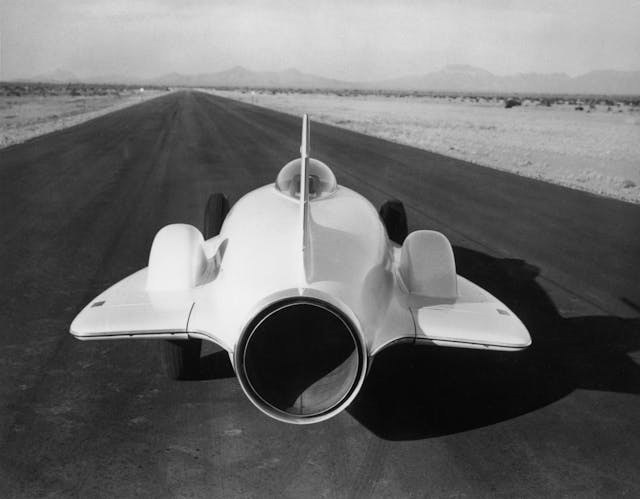
Most of the jet vehicles early on were slender, one-engine contraptions. From 1970–1974, four jet car pilots were killed, and some sanctioning bodies outlawed them. But the safety record has been quite good since. Five years ago, Kat Moller died in a single-engine jet car at the makeshift Sebring International Raceway drag strip when her car strayed over the center line and hit a timing box in the center of the track, which entered the cockpit and killed her. She was 24. Green Mamba driver Doug Rose lost control of his legendary single-engine jet car at a Michigan oval track and crashed, but he may well have died from natural causes. He was 80.
As for Les Shockley, in 1984 he mounted three Westinghouse J34 just engines, likely salvaged from (three) Navy T2-A Buckeye trainers, onto the rear of a 1984 Peterbilt semi. Shockwave was thereby born. It was so popular that Shockley built other jet trucks, including the smaller Super Shockwave, a two-engine monster that resembles a 1957 Chevrolet pickup truck.
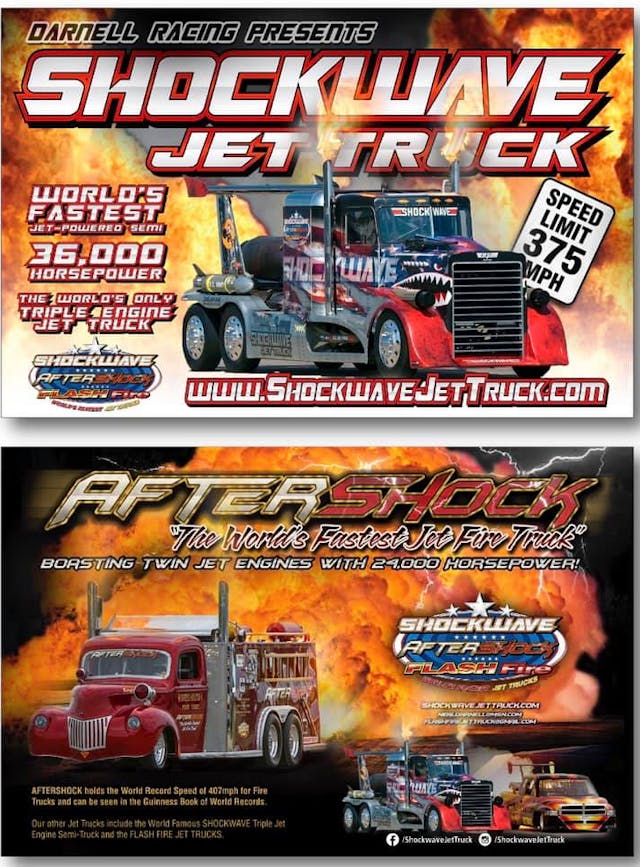
But it was the original Shockwave everybody wanted to see. Before Shockley retired to the Philippines, where he died several years ago, he sold the Shockwave to Darnell Racing Enterprises of Springfield, Missouri—a logical move given that Neal Darnell had driven the Shockwave. They continued to campaign it, alongside another smaller, cheaper-to-book car called the Aftershock, which resembles a fire truck. They also had the Flash Fire, a jet-equipped pickup truck, which the Darnells used to roast a turkey in just five seconds as a publicity gag.
***
When all goes as planned, riding in a vehicle like this isn’t as extreme as you might think.
Hayden Proffitt II, who comes from a long line of drag racers, fueled the Hot Streak II with the 150 gallons of diesel needed for a 300-mph practice run at Seymour Johnson Air Force Base in North Carolina. The Hot Streak II is really the Super Shockwave, the twin-engine jet truck Shockley built to accompany his original Shockwave. Profitt bought it and named it after the original Hot Streak his family used to race.
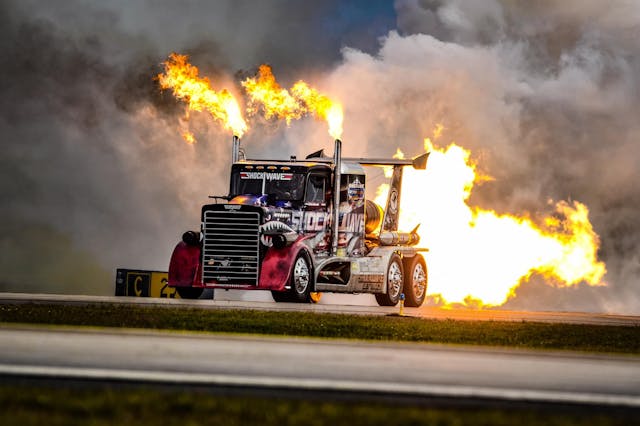
I put on my triple-layer Nomex suit and helmet. I buckled into the passenger seat, girding myself for a wild ride. A pickup towed us to the end of the runway, and Proffitt, a former military jet mechanic, set about fiddling with buttons and switches and in seconds, the Hot Streak came alive. I’d seen it perform at a San Antonio drag strip, where it rattled the glass windows in the press room until calk began flaking from the seams. When ceiling tiles started falling, the room cleared out.
At time of my ride in 2018, there were probably 35 jet vehicles in North America that performed. One looked like a military tank and went 200 mph. Another like an impossibly long Tow Mater, the tow truck from the movie Cars. All bowed before the Shockwave family.
I stared down at pavement beneath my feet, through the space where the non-existent engine is supposed to go. There is no floor. He spooled up the engines and took off. It was remarkably seamless and quiet to whoosh down the strip, and we came to an abrupt halt when the pair of military parachutes deployed.

“What do you think?” Proffitt asked.
“Calmer than I expected,” I reply.
“Like I told you, all the drama happens in the back.”
Even after my small taste, I can see what Chris and Neal Darnell savored in the Shockwave, and what thrilled thousands of drag strip and air show crowds. Chris Darnell was 40, a keeper of a storied relic that will never be duplicated.










